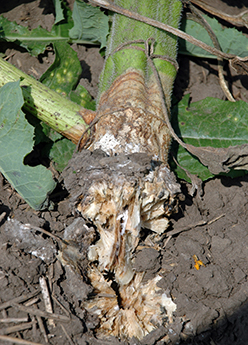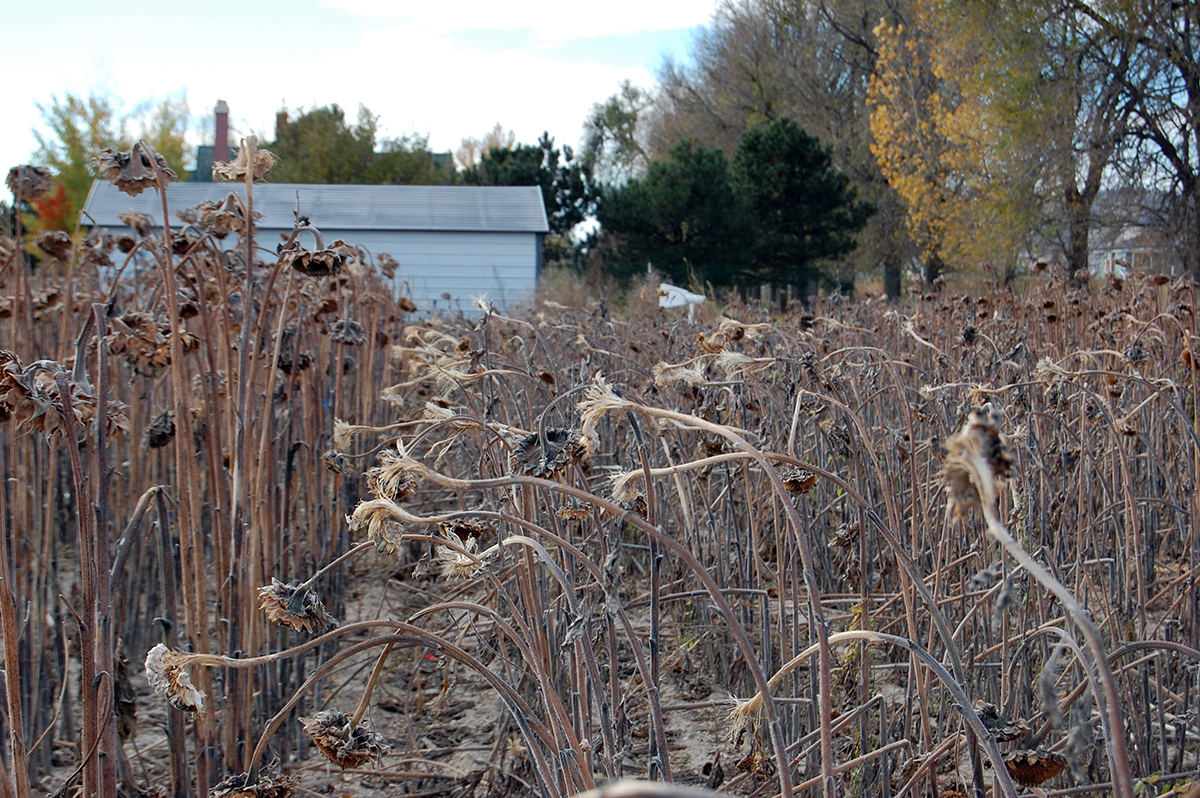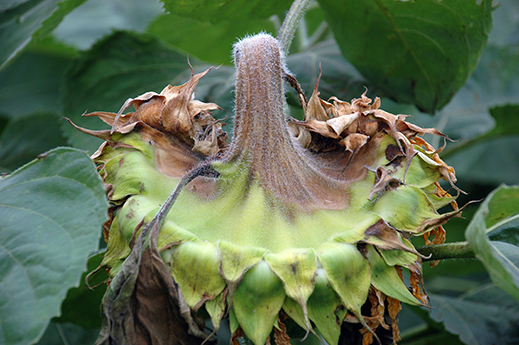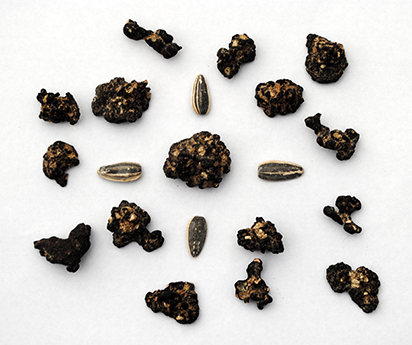Spanish VersionRussian VersionRelated Lesson: White mold (Sclerotinia)
Diseases caused by
Sclerotinia sclerotiorum (Lib.) de Bary are among the major production constraints of sunflower (Helianthus annuus L.) in the world (Harveson et al. 2016; Rashid et al. 2016). The causal fungus,
S. sclerotiorum, is also known to cause the disease “white mold" in many crops including soybean (Glycine max L.), canola (Brassica napus L.), and broadleaf weeds. The survival propagule of
S. sclerotiorum is the sclerotium, which has two germination mechanisms – carpogenic and myceliogenic – that allow the fungus to behave as an air-borne and a soil-borne pathogen, respectively. There are three distinct diseases caused by
S. sclerotiorum on sunflower – (1) Sclerotinia root rot, Basal stalk rot, and wilt; (2) Sclerotinia stem rot; and (3) Sclerotinia head rot and midstalk rot. The development of these diseases is favored by temperatures of 30˚C or below, prolonged wet conditions (e.g., rain, fog, dew, irrigation practices), and wet soils (Markell et al. 2015). The impact of
S. sclerotiorum on sunflower yield is dependent on the growth stage of the crop at the time of infection, agronomic practices, environmental conditions, and the type of disease (Gulya et al. 2019; Rothmann and McLaren 2018; Harveson et al. 2016; Rashid et al. 2016; Harveson 2011).
Symptoms and Signs
Sclerotinia root rot, Basal stalk rot, and wilt: The first above-ground symptom of Sclerotinia root rot, Basal stalk rot, and wilt is sudden wilting of the sunflower plants before or during flowering with wilted plants often being found in clumps. The causual fungus,
S. sclerotiorum, invades through the roots of the sunflower plants and can infect the adjacent plants through contact of the roots. Over time, tan-colored, water soaked lesions develop at the base of the plants (Fig. 1), which can girdle the stem. As the disease continues to develop on the plant, the stem appears bleached and shredded, and has a decayed pith. The infected plants can easily lodge in the field during high winds (Fig. 2). The time between wilting of infected plants and plant death is usually four to seven days. Black sclerotia (1 to 2 mm in diameter) can be found inside, and sometimes on the outside, of the stem. The presence of these relatively large sclerotia can help to distinguish Sclerotinia Basal stalk rot and wilt from other stem diseases such as Verticillium wilt and Charcoal rot (Markell et al. 2015).

Figure 1. Lesion produced by Sclerotinia sclerotiorum on the base of the stem
|

Figure 2. Lodging from Sclerotinia wilt and basal rot
|
Sclerotinia stem rot: Symptoms can appear any time after the seedling growth stages of sunflower but the disease occurs mostly at mid- to late- growing season of the crop. Initially, small, water- soaked lesions develop on the plants near the soil line. As the disease progresses, secondary symptoms can appear on the plant, which includes wilting, bleaching and shredding of the stem. The pith of the stem beneath the lesions often contains mycelial growth and abundant black sclerotia (Fig. 3). In addition, sclerotia are seen on the outside of the stem. As the disease progresses, the stem can break and shred with only the vascular elements visible (Fig. 4). Symptoms of Sclerotinia stem rot can be confused with those of Phomopsis stem canker. While Phomopsis stem canker lesions are light to dark brown in color, the stalks of the sunflower plants affected by Sclerotinia stem rot have sclerotia forming inside and outside the stem (Mathew et al. 2018).

Figure 3. Sclerotia produced by
Sclerotinia sclerotiorum inside the sunflower stem
|  Figure 4. Stems have a shredded appearance from
Sclerotinia infection Figure 4. Stems have a shredded appearance from
Sclerotinia infection |
Sclerotinia head rot and midstalk rot: This disease may be common before or after flowering. Symptoms of Sclerotinia head rot include dark-colored, water-soaked lesions on the backside of the sunflower heads or the presence of white mycelial growth, which covers the developing seeds in the head (Fig. 5). As the disease continues to develop,
S. sclerotiorum rots the inside of the head and large sclerotia fill the head below the seed layer and around the seeds. As the disease progresses, the sunflower head disintegrates and shreds, leaving behind large sclerotia (12 cm or greater in diameter). The head resembles a straw broom (Fig. 6 and Fig. 7) and can be easily seen from a distance in the field. Symptoms of Sclerotinia head rot can be confused with Rhizopus head rot (Markell et al. 2015). However, sunflower heads affected by Rhizopus head rot will exhibit gray-colored, threadlike mycelial strands with no sclerotia (Fig. 8).

Figure 5. White mycelial growth and sclerotia of
Sclerotinia sclerotiorum on the sunflower head
|
 Figure 6. Sunflower head looking like straw broom because of
Sclerotinia infection
Figure 6. Sunflower head looking like straw broom because of
Sclerotinia infection |
 Figure 7. Figure 7.
|
 Figure 8. Sunflower head affected by Sclerotinia head rot can resemble Rhizopus head rot
Figure 8. Sunflower head affected by Sclerotinia head rot can resemble Rhizopus head rot
|
Pathogen Biology
Sclerotinia sclerotiorum overwinters as sclerotia in the soil or crop debris, which enables the fungus to survive for three to five years. Sclerotia can be irregularly shaped, and range in size from 2 to 5 mm in diameter and up to 2.5 cm in length (Fig. 9; Heffer Link and Johnson 2007). Depending on the environmental conditions, sclerotia can germinate carpogenically to produce apothecia (and ascospores) and infect aboveground plant parts of the host or myceliogenically to directly infect the roots of sunflower plants (Bardin and Huang 2001; Bolton et al. 2006).

Figure 9. Sclerotia produced by
Sclerotinia sclerotiorum can vary in shape and size |
For carpogenic germination, sclerotia of the fungus, lying on or within 2 cm of the surface of the soil, germinate to form cup-shaped structures called apothecia (Harveson 2011; Heffer Link and Johnson 2007). The formation of apothecia is favored by air temperatures between 10 and 25˚C, high relative humidity (from dense canopies), and high soil moisture (from irrigation practices or rain) for one to two weeks (Bolton et al. 2006; Clarkson et al. 2004). Apothecia consist of a stipe (20 to 80 mm long) and a flat to concave, tan-colored receptacle (2 to 10 mm diameter) that supports the asci-bearing tissue, the hymenium (Bolton et al. 2006). The asci forcefully discharge ellipsoid-shaped ascospores (8 to 15 x 5 to 8 µm; Brooks 1953), when triggered by sudden decrease in relative humidity or from disturbance of the apothecium (Hartill and Underhill 1976). Ascospores are single hyaline cells and have thin walls. These spores require temperatures between 20 to 25˚C, 48 to 72 hours of leaf wetness (e.g., dew, rain), and a nutrient source (e.g., dead or senescing plant tissues, or exudates from the nectaries) for germination (Rothmann and McLaren 2018; Abawi and Grogan 1979). Ascospores survive for about two weeks after release from apothecia.
For myceliogenic germination, sclerotia of
S. sclerotiorum germinate to produce hyphae that can directly attack sunflower (Harveson 2011). Hyphal germination of sclerotia will occur when the soil is wet (water holding capacity of between 30 and 100%) and cool (temperatures of 12 to 24˚C) from rain or irrigation practices (Rothmann and McLaren 2018; Heffer Link and Johnson 2007). Infection of plants following hyphal germination of sclerotia enables the fungus to penetrate into the lateral roots, tap root, stem causing Sclerotinia root rot, basal stalk rot, and wilt.
Disease Cycle and Epidemiology
Sclerotinia root rot, Basal stalk rot, and wilt: Sclerotinia sclerotiorum can infect sunflower through the roots. In early summer, particularly in fields with a history of white mold, the sclerotia can germinate to produce white-colored mycelium upon contact with roots of sunflower plants. The fungus penetrates into the lateral roots and then the taproot causing decay of the root system. The contact between infected roots and roots of adjacent healthy plants within rows allows
S. sclerotiorum to spread from plant to plant. The fungus grows through the roots into the stem, and the plant wilts. As the disease progresses, sclerotia are formed in the decaying stem and roots. These sclerotia return to the soil when the plants lodge or during harvest and can serve as inoculum source for the next susceptible crop. An important factor that can affect disease incidence is the inoculum density of sclerotia present in the soil. The higher the inoculum density of sclerotia, the longer the field will remain infested (Harveson 2011; Holley and Nelson 1986). For example, the research by Holley and Nelson (1986) showed that an inoculum density of less than one sclerotium per 800 cm3 of dry soil can result in an average incidence of Sclerotinia wilt of 40% on sunflower plants.
Sclerotinia stem rot: Apothecia produced by
S. sclerotiorum can be observed in the sunflower field until after the crop canopy closure and ascospores produced by apothecia can originate from within the sunflower field. Additionally, ascospores can blow in from the neighboring fields where apothecia may be present. These spores land on leaves and petioles of sunflower plants. Upon availability of free moisture and nutrients, ascospores germinate and infect the leaves and petioles and progress to the stem, causing Sclerotinia stem rot (Harveson et al. 2016; Harveson 2011).
Sclerotinia head rot and midstalk rot: Ascospores are the infective propagule and they require leaf wetness and nutrients to infect. Like stem rot, ascospores use the dead florets and pollen as the nutrient base to germinate. The spores penetrate into the receptacle and decay the entire head.
Sclerotinia sclerotiorum can infect the sunflower seed, and exist as mycelia in the seed coat, but the infected seed is of less importance for disease development (Harveson et al. 2016; Harveson 2011).
Disease Management
Tillage: Use of a no-tillage operation can enhance the germination of sclerotia present on the soil surface. However, combining no-till with use of a non-host crop can reduce the number of sclerotia that can infect a host crop in the subsequent season. In contrast, deep tillage practices can help reduce sclerotial numbers present on the soil surface; however, plowing in a subsequent season can return the buried sclerotia to the soil surface.
Crop Rotation: For the three diseases, a rotational break of three to five years with non-hosts [e.g. wheat (Triticum L.), sorghum (Sorghum bicolor (L.) Moench), and corn (Zea mays L.] can reduce the number of sclerotia (Harveson 2011; Heffer Link and Johnson 2007). In the absence of sunflower (or other susceptible crops), sclerotia may germinate, but without infection of a susceptible host, new sclerotia are not produced and their numbers gradually reduce. However, once
S. sclerotiorum is established in a field, crop rotation may not be effective because sclerotia can survive for many years (Heffer Link and Johnson 2007).
Irrigation: Irrigating sunflower on field soils with high water holding capacity should be avoided, especially during flowering, to prevent carpogenic germination of sclerotia (Weber 2017; Scherer 2007).
Plant population and row spacing: For management of diseases caused by
S. sclerotiorum on most crops including sunflower, it is recommended to plant minimal populations with wide rows (Harveson et al. 2016; Zimmer and Hoes 1978).
Nitrogen fertilization: Excessive rates of nitrogen in sunflower fields should be avoided as excess nitrogen can promote dense canopies and provide the microclimate for disease development (Weber 2017; Harveson et al. 2016).
Weed management: Broad-leaf weeds that may be present in a sunflower field can be hosts of
S. sclerotiorum and these include Canada thistle (Cirsium arvense (L.) Scop.), Jerusalem artichoke (H. tuberosus L.), common lambsquarters (Chenopodium album L.), nightshade (Solanaceae Juss.), pigweed (Amaranthus L.), ragweed (Ambrosia L.), soybean, velvetleaf (Abutilon theophrasti Medik.), vetch (Vicia L.), and wild sunflower (H. annuus) (Heffer Link and Johnson 2007). These weeds can contribute to inoculum survival and dissemination for all the three diseases, and therefore, it is important to manage them.
Biological control: There are mycoparasites, such as
Coniothryium minitans Campbell, which can directly attack the sclerotia produced by
S. sclerotiorum. Applications of
C. minitans (Contans WG, Bayer CropScience, Research Triangle Park, NC) directly to the soil (depending on pre-plant or post-harvest of the crop) can help the fungus colonize and kill the sclerotia (Bradley et al. 2007). In addition, applications of
C. minitans made after harvest, especially following severe disease on sunflower, can help reduce the number and survival of sclerotia (Weber 2017). However, effective and economical control of diseases caused by
S. sclerotiorum using
C. minitans under field conditions is yet to be established (Harveson et al. 2016). Additionally, immediate planting of a susceptible crop [e.g. soybean, canola, potato (Solanum tuberosum L.)] into a field with history of white mold is not advisable.
Chemical control: Fungicides (ground, aerial and/or application through an irrigation system) are used in the U.S. for disease management. Currently, sunflower farmers are limited to fungicides with active ingredients in the FRAC Groups 3 (e.g., metconazole and tebuconazole), 7 (e.g., boscalid, fluopyram, and penthiopyrad), and/or 11 (e.g., azoxystrobin and pyraclostrobin) to manage these diseases. For Sclerotinia wilt/Basal stalk rot, seed treatments containing active ingredients in the FRAC Group 11 (e.g., pyraclostrobin) may protect the sunflower seed during the seedling growth stage. For Sclerotinia head rot and midstalk rot, fungicides containing active ingredients in the FRAC group 7 (e.g., penthiopyrad) are labelled. However, results from the fungicide efficacy data are either not available or not consistent across years and/or locations (Seiler et al. 2017).
Genetic resistance: No major genes have been identified in cultivated sunflower that can confer complete resistance to
S. sclerotiorum (Seiler et al. 2017). The genetics of resistance to diseases caused by
S. sclerotiorum is quantitative, which complicates the efforts to breed for resistant varieties. In the last decade, there has been advances in research to identify sources of resistance against
S. sclerotiorum in sunflower, particularly for Sclerotinia basal stalk rot and head rot. As examples, Block et al. (2010, 2009) tested 460 accessions from 14 annual wild species of
Helianthus for resistance to Sclerotinia basal stalk rot and identified
H. argophyllus Torr. and Gray,
H. debilis,
H. praecox Engelm. and Gray, and
H. petiolaris Engelm. and Gray as potential resistance sources. Talukder et al. (2014) tested 260 plant introductions (including USDA-ARS inbred lines) over multiple years and locations in the U.S. states of Minnesota, North Dakota, and South Dakota. Two plant introductions, PI531389 and PI531366, were determined to be significantly resistant against Sclerotinia basal stalk rot and head rot when compared to the susceptible checks. However, the incidence of head rot on these plant introductions was negatively correlated with that of basal stalk rot, indicating that the genes conferring resistance to the two diseases may be different (Talukder et al. 2014). Seiler et al. (2017) identified nine cultivated oilseed accessions from the Agricultural Research Council in South Africa (Grain Crops Institute, Potchefstroom, South Africa) that had basal stalk rot disease incidence less than or equal to that of the moderately resistant oilseed hybrid. Talukder et al. (2019) transferred genes conferring resistance to Sclerotinia basal stalk rot from
H. praecox into cultivated sunflower. As for Sclerotinia stem rot, since the last research by Miller and Gulya (1999) who developed maintainer and restorer oilseed lines with disease tolerance, no progress in research has been made to improve disease resistance in cultivated sunflower.
Significance
The diseases caused by
S. sclerotiorum on sunflower, Sclerotinia root rot, Basal stalk rot, and wilt; Sclerotinia stem rot; and Sclerotinia head rot and midstalk rot, are responsible for high yield losses in the U.S. and other sunflower producing countries of the world. For example, yield losses of 10 to 20% have been observed for Sclerotinia head rot (Gulya et al. 2019) and 5 to 70% for Sclerotinia wilt/ Basal stalk rot (Kolte 1985) in commercial sunflower fields. In addition to yield, Sclerotinia head rot can also affect the quality of seed by reducing the oil content in the seed by 10 to 15% and increasing the content of free fatty acid, leading to rancidity of the oil (Gulya et al. 2019). Management of the diseases caused by
S. sclerotiorum is limited to rotation with non-host crops (such as corn, wheat), selection of resistant hybrids (if available), proper irrigation practices, weed management, and biological control. Currently, there are three fungicide groups registered on sunflower for use against these diseases, but the efficacy data are not available or not consistent across years and/or location. Thus, to manage diseases caused by
S. sclerotiorum, breeding and developing hybrids with partial resistance to the fungus is the most effective management option. However, lack of effective sources of resistance in cultivated sunflower and the quantitative nature of disease resistance have hampered the progress in the development of sunflower hybrids with resistance to
S. sclerotiorum.
References
Abawi, G. S., and Grogan, R. G. 1979. Epidemiology of diseases caused by Sclerotinia species. Phytopathology 169: 899-904.Bardin, S.D., and Huang, H.C. 2001. Research on biology and control of
Sclerotinia diseases in Canada. Can. J. Plant Pathol. 23: 88-98.Bolton, M. D., Thomma, B., and Nelson, B. D. 2006.
Sclerotinia sclerotiorum (Lib.) de Bary: biology and molecular traits of a cosmopolitan pathogen. Mol. Plant Patho. 7: 1-16.Block, C. C., Rashid, K. Y., and Gulya, T. J. 2016. Sclerotinia root rot, basal stalk rot, and wilt. Pages 57-59 in: Compendium of Sunflower Diseases and Pests. R. M. Harveson, S. G. Markell, C. C. Block, and T. G. Gulya, eds. American Phytopathological Society, St. Paul, MN.Block, C. C., Marek, L. F., and Gulya, T. J. 2010. Evaluation of wild
Helianthus species for resistance to Sclerotinia stalk rot. Proceedings of the 8th Annual Sclerotinia Initiative Meeting, Bloomington, MN, USA, January 20-22, 2010.Block, C. C., Marek, L. F., and Gulya, T. J. 2009. Evaluation of wild
Helianthus species for resistance to Sclerotinia stalk rot. Proceedings of the 7th Annual Sclerotinia Initiative Meeting, Bloomington, MN, USA, January 21-23, 2009.Bradley, C., Markell, S., and Gulya, T. 2007. Irrigation management. Pages 54-77 in: Sunflower Production. D. R. Berglund, ed. North Dakota State University Extension, Fargo, ND, USA.Brooks, F. T. 1953. Plant Diseases. Oxford Univ. Press, London, UK.Clarkson, J. P., Phelps, K., Whipps, J. M., Young, C.S., Smith, J. A., and Watling, M. 2004. Forecasting
Sclerotinia disease on lettuce: toward developing a prediction model for carpogenic germination of sclerotia. Phytopathology, 94: 268-279.Gulya, T., Harveson, R., Mathew, F., Block, C., Thompson, S., Kandel, H., Berglund, D., Sandbakken, J., Kleingartner, L., and Markell, S. 2019. Comprehensive disease survey of U.S. sunflower: disease trends, research priorities and unanticipated impacts. Plant Dis. 103: 601-618.Hartill, W. F. T., and Underhill, A. P. 1976. 'Puffing' in
Sclerotinia sclerotiorum and
S. minor. New Zeal. J. Bot. 14: 355-358Harveson, R. M., Markell, S. G., Block, C. C., and Gulya, T. J. 2016. Compendium of Sunflower Diseases, 1st ed. American Phytopathological Society, St. Paul, MN, USA.Harveson, R. M. 2011. Sclerotinia diseases of sunflower in Nebraska. NebGuide G2107, University of Nebraska Cooperative Extension, Lincoln, NE, USA. http://extensionpublications.unl.edu/assets/pdf/g2107.pdf Heffer Link, V., and Johnson, K. B. 2007. White Mold. The Plant Health Instructor. DOI: 10.1094/PHI-I-2007-0809-01. Updated 2012.Holley, R. C., and Nelson, B. D. 1986. Effect of plant population and inoculum density on incidence of Sclerotinia wilt of sunflower. Phytopathology 76: 71-74.Huang, H. C., and Hoes, J. A. 1980. Importance of plant spacing and sclerotial position to development of Sclerotinia wilt of sunflower. Plant Dis. 64: 81-84.Kolte, S. J. 1985. Diseases of annual edible oilseed crops volume III sunflower, safflower, and nigerseed diseases. CRC Press, Boca Raton, FL, USA.Markell, S., Harveson, R., Block, C., and Gulya, T. 2015. Sunflower Disease Diagnostic Series. Publication PP1727. North Dakota State University Cooperative Extension Service, Fargo, ND, USA.Masirevic, S., and Gulya, T. J. 1992.
Sclerotinia and
Phomopsis – two devastating sunflower pathogens. Field Crop Res. 30: 271-300.Mathew, F., Harveson, R., Gulya, T., Thompson, S., Block, C., and Markell, S. 2018. Phomopsis stem canker of sunflower. Plant Health Instructor. DOI: 10.1094/PHI-I-2018-1103-01.McLaren, D. L., Rimmer, S. R., and Huang, H. C. 1988. Survey of Sclerotinia wilt and head rot of sunflower in southern Alberta, 1987. Can. Plant Dis. Surv. 68: 126-127.Miller J. F., and Gulya T. J. 1999. Registration of eight
Sclerotinia-tolerant sunflower germplasm lines. Crop Sci. 39: 301-302.Rashid, K. Y., Block, C. C., and Gulya, T. J. 2016. Sclerotinia head rot and midstalk rot. Pages 51-55 in: Compendium of Sunflower Diseases and Insects. R. M. Harveson, S. M. Markell, C. C. Block, and T. J. Gulya, eds. The American Phytopathological Society, St. Paul, Minnesota, USA. Pp: 51-55. Rothmann, L.A., and McLaren, N. W. 2018.
Sclerotinia sclerotiorum disease prediction: A review and potential applications in South Africa. S. Afr. J. Sci. 2018; 114, Art. #2017-0155, 9 pages. http://dx.doi.org/10.17159/sajs.2018/20170155.Scherer, T. 2007. Irrigation management. Pages 16-17 in: Sunflower Production. D. R. Berglund, ed. North Dakota State University Extension, Fargo, ND, USA.Sedun, F. S., and Brown, J. F. 1989. Comparison of three methods to assess resistance in sunflower to basal stem rot caused by
Sclerotinia sclerotiorum and
S. minor. Plant Dis. 73: 52-55.Seiler, G., Misar, C. G., Gulya, T. J., Underwood, W. R., Flett, B. C., Gilley, M., and Markell, S. G. 2017. Identification of novel sources of resistance to Sclerotinia basal stalk rot in South African sunflower germplasm. Plant Health Prog. 18: 87-90.Talukder, Z. I., Long, Y., Seiler, G. J., Underwood, W., and Qi, L. 2019. Introgression and monitoring of wild
Helianthus praecox alien segments associated with Sclerotinia basal stalk rot resistance in sunflower using genotyping-by-sequencing. PLOS ONE 14: e0213065.Talukder, Z. I., Hulke, B. S., Marek, L. F., and Gulya, T. J. 2014. Sources of resistance to sunflower diseases in a global collection of domesticated USDA Plant Introductions. Crop Sci. 54: 694-705.Weber, J. M. 2017. Management of white mold in hybrid sunflower seed crops in the Columbina basin of Central Washington. MS Thesis, Washington State University, Pullman, WA, USA.
Zimmer, D. E., and Hoes, J. A. 1978. Diseases. In: Carter, J. F. (Ed.). Sunflower science and technology. Madison: American Society of Agronomy. p. 225-262.
